July 31st 1520 GMT
It cleared unexpectedly and I was able to do some proper full disc and close-up shots of the Sun. There were no sunspots on the professional images, so I did not attempt any white light shots.
July 31st 1220 GMT
Conditions were almost impossible but with bad weather forecast for the next few days, I decided to proceed with a solar hydrogen alpha shoot anyway.
All frames were badly afflicted by cloud, so I did not try to process any.
July 29th 1540 GMT
The Sun was quiet in hydrogen alpha light. I just took a set of full disc shots.
July 27th 1550 GMT
There was some clear sky but the Sun was very quiet in hydrogen alpha light.
July 25th 1610 GMT
Conditions were poor but I took some full disc hydrogen shots anyway. Two frames had sizeable areas of the solar disc that were unaffected by cloud.
July 24th 2230 GMT
After a wet day, it finally cleared after sunset. There were clear patches of sky but there was haze to the east. I tried to capture some early Perseids on film.
I used a focal reducer to achieve a focal length of 8mm on my DSLR. As I decided take multiple frames, I used a fixed exposure time of 30 seconds and ISO 800. I also shot several dark frames. I stacked 7 images in Deep Sky Stacker and finished in GIMP. No Perseids, though.
I noticed that some of the low cloud in the east was illuminated, heralding moonrise. I switched to 300mm ISO 6400 and 3 seconds exposure and shot a few frames of the Wild Duck Cluster (M11). Deep Sky Stacker did not work, so I stacked 41 images in Microsoft ICE and finished in GIMP.
I aimed in the rough direction of M81 and M82 in hope. I did not capture them but stacked 10 frames to get some background stars.
I finished with Melotte 20. I rather liked this one, composed of 16 frames stacked in DSS and finished in GIMP.
By the time I had shot some dark frames, the Moon had risen. I shot some frames at ISO400, 300mm and 1/1000 second exposure. Unfortunately, the result was too fuzzy to use.
July 23rd 1735 GMT
The Sun was quiet, with the sunspots gone. I just took some full disc shots with my PST.
July 23rd 0015 GMT
There was a lot of haze which was scattering moonlight. I took some full disc lunar frames with my DSLR at 300mm, ISO 800 and 1/4000 second.July 22nd 1105 GMT
I checked the Sun with my PST. Apart from the sunspots, the solar disc seemed very bland. I took just full disc shots.
July 22nd 1055 GMT
After a previous out of focus attempt, I took some shots of the Sun with my DSLR at 300mm, ISO 100 and 1/2000 second exposure.
July 21st 2330 GMT
There was some clear sky, so I took some full disc frames of the Moon with my Mak and DSLR at ISO 400 and 1/1600 seconds exposure.
July 20th 1005 GMT
It was somewhat cooler than the day before but sill rather hot. I decided to do just a hydrogen alpha shoot. Was that a prominence I saw? No. just wishful thinking. At least the sunspots and surrounding areas were still there.
I took some full disc shots and close-ups of the active area.
July 19th 1435 GMT
With temperatures around 33 degrees, it felt too hot to lug a big Mak out, so I just used my PST to record the Sun in hydrogen alpha light.
I stacked eight images and, for the first time for ages, caught a prominence on "film".
July 18th 2145 GMT
It was clear, like the night before but I changed position, so I could see Mars.I did some focus shots on the Moon before using a 3X Barlow lens and trying it on Mars. I had to do some fiddling with the exposure until I settled on 1/20 second at ISO 400.
Next was Saturn that needed a longer exposure of 1/10 second, although I could have used a higher ISO.
I returned to the Moon at 1/200 second and took some close-ups.
I then did some lunar full disc frames.
I ended up attempting shots of Saturn's moons at ISO 6400 and one set of frames at 1/2 second and another set at 1 second.
July 18th 1650 GMT
I returned with my PST and compact digital camera. Apart from the active region, the solar disc seemed somewhat bland.
I took some full disc shots and close-ups.
July 18th 1620 GMT
I had a clear patch of sky, so I photographed the Sun with my Mak and DSLR. I did a set of full disc shots at ISO 400 and 1/2000 second exposure.
I then did close-ups of the active region at 1/200 second exposure.
July 17th 2245 GMT
I took out the Mak and DSLR and started on the Moon.
I took 73 frames of the full disc at ISO 400 an 1/2000 second exposure.
I inserted a 3x Barlow lens and took two sets of close-ups with 1/200 second exposure. This gave a focal length of about 4.5m.
Unfortunately, many these came out fuzzy. However, some frames worked, so I stacked them.
I tried the same set-up on Saturn but tried various exposures down to 1/20 second.
I tried the same set-up on Saturn but tried various exposures down to 1/20 second.
I finally took a few frames of Saturn without the Barlow lens and ISO 6400 at 1/2 second in an attempt to capture some moons. I was only able to use one frame, as the stack failed. Now I cannot tell you which are background stars and which are moons but I think it looks nice anyway.
July 17th 1630 GMT
Conditions were not much better in the afternoon but I did some shots with my PST. I did not see any detail through the eyepiece.
July 17th 1150 GMT
The days before had been cloudy, with rain at times. It was clearer than the day before but I did not have a clear view of the Sun. I bin scanned it through cloud and saw three sunspots.
July 14th 0640 GMT
I checked the Sun with my PST. I saw a sunspot and some bright faculae, one a horseshoe shape, although most of the solar disc was bland, even in hydrogen alpha light. I took some full disc frames plus two close-ups of the most active regions.
July 13th 1220 GMT
I bin scanned the Sun through thin cloud and saw a sunspot.
July 12th 1730 GMT
Although the Sun was behind a bank of cloud, the Moon was in a clear patch of sky. I used the Mak and DSLR to take 154 full disc shots at 1/500 second and ISO 800. I tried some different processing, based on what I had been doing with the Sun by using the green channel only. Without too much trumpet blowing, it was my best ever daylight Moon shot.
July 11th 1650 GMT
I caught a brief spell of clear sky in the west, so I checked out the Sun with my PST. The solar disc looked very bland, so I just took some full disc shots.
July 10th 1625 GMT
After a very wet and cloudy day, there was a break in the clouds. I took two sets of frames.
Firstly, I stacked 6 full disc shots to get this.
I didn't get a full disc from all close-ups but managed a fair part of it.
I then processed the regions for which I had stacked images.
I then processed the regions for which I had stacked images.
July 9th 1515 GMT
I bin scanned the Sun through hazy moving cloud but did not see the sunspot I had seen on the Big Bear images.
July 8th 1700 GMT
I bin scanned the Sun and didn't see any sunspots. I checked out the Moon and Mare Crisium was out of the shadows and a few craters were visible.
July 6th 1000 GMT
Conditions were hazy but were forecast to become worse during the day. I checked the Sun with my PST and, after the excitement of the day before, had returned to its former, quiet self. I took some full disc shots and regional shots of each quadrant.
The full disc shots were stacked from 9 of 10 frames.
The first quadrant shot was composed from 3 frames,
The second attempted quadrant shot was composed from 6 of 7 frames.
The third close-up was composed from 7 of 7 frames.
The fourth close-up was composed from 4 of 5 frames.
The third close-up was composed from 7 of 7 frames.
The fourth close-up was composed from 4 of 5 frames.
July 5th 1550 GMT
I had some trouble with cloud but saw a filament and prominence on the solar surface.
July 5th 1100 GMT
A solar bin scan through moving cloud did not reveal any sunspots.July 4th 2310 GMT
I reset the camera to ISO 800 18mm focal length and 30 seconds' exposure.
My first target was Sagittarius. I found one of the frames ha caught two meteors.
Next was Ophiuchus. As with the previous target, DSS did not work but I stacked 7 frames in Microsoft ICE and finished in GIMP. This was my first ever shot of the full constellation.
While out I had my first decent binocular browse for a long time. I was pleased to see M22, a global cluster in Sagittarius. It always seems brighter than its published magnitude suggests but, due to declination, is not a common sight from the UK.
I also potted M15, M12, M13, M10 and M92, more globular clusters than usual.
I saw Melotte 20, M34 and M11.
The only galaxy I saw was M31 (Andromeda Galaxy) and I also saw the North America Nebula, M8 and M20.
The number of stars along the galactic plane was truly amazing and I also saw Saturn's rings.
One of my best night sessions for ages.
July 3rd 2245 GMT
I wanted to do this shot for some time: Mars with Saturn. I had to find a spot in the neighbourhood as far from street lights as possible. I took 12 light frames at 26mm focal length ISO 800 and 10 seconds exposure and shot 17 dark frames. The frames did not stack with Deep Sky Stacker, so I used Microsoft ICE instead.
July 3rd 1635 GMT
The Sun was quiet in hydrogen alpha light but I could see some shading features with my PST. I took one set of 11 full disc images and stacked them. I finished off in GIMP and (again) found a blue colour showed the minimal contrast to best effect.July 2nd 2210 GMT
My recent attempts at webcamming and DSLRing planets had not been great, so I resorted to the good old-fashioned afocal projection.
Jupiter was shining through a tree and simply too close to the Sun, so it was gone for a while. I started with my Mak and 10mm eyepiece giving 103x magnification. I saw some shading, possibly Syrtis Major. I used a 2x Barlow lens but the image wasn't quite steady. I could see a bit more. I took some snaps with each setting.
I found Saturn with the Barlow lens in place. The Cassini Division wasn't clear but
I could make out a couple of cloud belts.
July 2nd 0635 GMT
I checked the Sun in hydrogen alpha light with my PST. There were no prominences and the disc was very quiet. I was able to stack three good-sized full disc shots, so did not need to process the close-ups.
I experimented with various colour settings. Whilst I like the idea of colouring the Sun red, I found that a blue shade revealed most detail, including some small filaments. This was almost remarkable, considering how bland the solar disc was.








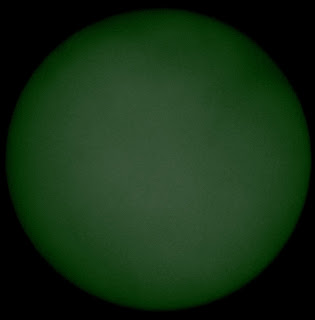





















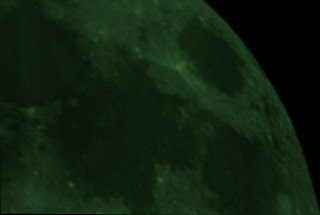



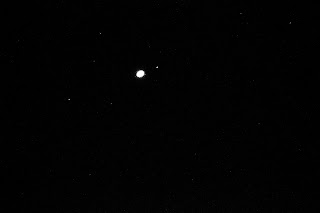




















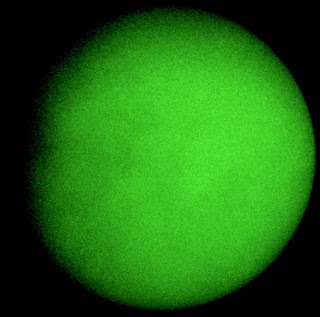












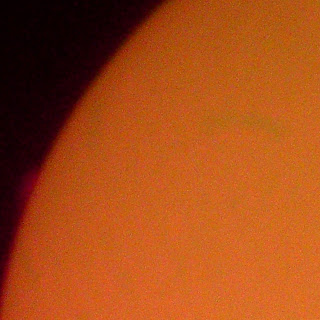












No comments:
Post a Comment